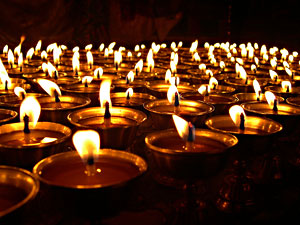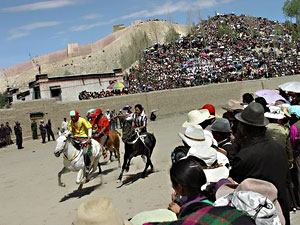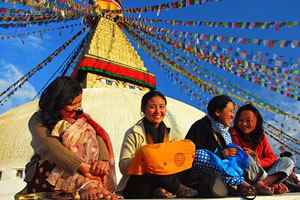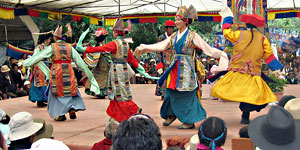|
|
Tibet Festivals |
|
The various
festivals in Tibet are celebrated according to the lunar
calendar. These festivals are Butter Lamp Festival, Saga Dawa
Festival, Horse Racing Festival, Yarlong Cultural Festival,
Ganden Festival, Harvest Festival, Ongkor Festival, Bathing
Festival, Losar Festival or Tibetan New Year and Shoton
Festival. |
|
|
|
Butter Lamp Festival
The Butter Lamp Festival is also known as the Lantern
Festival or Chunga Choepa festival. The last day of the
Great Prayer Festival or January 15 of the Tibetan
calendar is celebrated as Butter Lamp festival. This
festival originated when a noted patron of Tsong Khapa,
illuminated numerous butter- lamps in 1409 to honor the
victory of Sakyamuni in a debate over a non- Buddhist
opponents. According to Tibetan literature, Tsong Khapa,
dreamed that he arrived at a hillside full of withered
grasses and thorns, but suddenly all the withered
grasses became flowers and all the thorns |
 |
|
|
became bright
lamps, among which all kinds of jewelleries were shining
brilliantly. Such a wonderful picture mystified him and he
commissioned monks to light butter lamps before the sculpture
of Sakyamuni and shape all kinds of flowers and trees with
colored butter and decorated with jewelries to create a scene
similar to his dream. This tradition has been maintained to
this day. Large scale butter sculptures about stories of
Buddha, figures, flowers, birds, and animals are displayed and
people sing and dance in great joy throughout the night. The
Barkhor street of Lhasa turns into a grand exhibition site on
the night of this festival.
Saga Dawa Festival
The Saga Dawa Festival is one of the most important festivals
for Tibetan Buddhism which is celebrated to commemorates
Shakyamuni's Buddhahood and the death of his mortal body. It
is celebrated on 15th day of the 4th lunar month of Tibetan
calendar. This day is considered holiest in Tibet as various
memorable occasions like Buddha's birth, enlightenment and
Nirvana took place on the same day. It is also believed that
on this day, the gods in heaven descended to the mortal world.
Pilgrims and secular folks visit Lhasa and
the festival is observed by turning prayer wheels, having
vegetarian lunch and a picnic by the Dragon King Pond. As the
incense sticks are also lit in large numbers, the day is also
known as the World's Incense Day. Folk entertainers perform
Tibetan tradition and pay their homage to Buddha. People
observe a vegetarian rule, refrain from killing domestic
animals and give out alms during the month. At every monastery
sutras are recited and 'Cham' dances are performed. It is said
that good deeds in the month of this festival deserve 300 fold
in return and this leads many people to donate large sums to
the religious orders, monasteries and to the beggars that
gather at this time of year.
Ganden Festival
On the 15th day of the 6th Tibetan month, during the Ganden
Festival, 25 precious articles belonging to Ganden monastery,
which are normally locked in their treasure house, are
displayed in the main shrine hall. A grand offering ceremony
accompanies the display. These articles consist of the images
of the sixteen arhats, akshobhya, the secret assembly, the
four great kings, the upasaka and hashang image. |
|
|
|
Horse Racing Festival
Horse Racing Festival is celebrated in Gyantse in the
month of July. Horse racing and archery were first
started in Gyantse in 1408. During the festival, horse
races, archery, and shooting on galloping horseback were
followed by a few days of entertainment and picnicking.
Ball games, track and field events, folk songs and
dances, and barter trade were later added to it.
Yarlong Cultural Festival
Yarlong Cultural Festival plays an important part in the
Tibetan and whole world's culture. |
 |
|
|
The festival
is a combination of both art and economy, which displays the
old brilliance and the new expectations at the same time.
There are colorful activities like national sports contests,
singing, dancing, Tibetan opera, ethnic costume shows and
trade fairs.
Harvest Festival
The farmers in Lhasa, Gyantse and Shangnan celebrate the
harvest festival. During this festival, the people enjoy with
horse racing, games, costume fashion show, songs and dance,
archery and picnic etc.
Ongkor Festival
The Ongkor Festival is an old festival in farming areas of
Tibet. In Tibetan language “Ong” means field and “kor” means
rotating. So, “ongkor” means walking round the field or
surrounding the farmland. This festival is celebrated by
Tibetans to celebrate agricultural harvest. The festival is
held in each August according to Tibetan calendar when all
crops are waiting for harvest. The “Ongkor” not only shows
people’s wish for a good harvest, but also a good time for
them to rest. The Festival lasts for three days, which
entertain not only gods but also common human beings. Farmers
are plunged into a carnival at these days. On the day,
Tibetans dress themselves in holiday best and walk around
their fields, some carrying colorful flags, some lifting
barley and harvest pagoda made of ear of wheat with white hada
hanging around, some beating drums and gongs, singing songs
and Tibetan operas, some holding the portrait of Chairman Mao.
After that, people set up tents and take barley wines. They
also hold traditional activities and contests such as horse
racing, yak racing, shooting, riding to pick up hada, singing
and dancing contest and Tibetan opera contest, stone holding
and wrestling.
Bathing Festival
The Bathing Festival is celebrated in Lhasa. When Venus rises
over the Holy Bottle Mountain in the southeast, the Lhasans
tell one another: "The Bathing Festival begins." The Star
appears only for seven nights a year, and correspondingly the
Bathing Festival lasts for seven nights, too. This festival is
held from the 6th to the 12th day of the 7th Tibetan month. It
is believed when the sacred planet Venus appears in the sky;
the water in the river becomes purest and cures diseases.
During its appearance for one week in the sky, all the people
in Tibet take a ceremonial bath in the waters of their local
rivers or natural springs. Everybody, the young in particular,
go to rivers to take a holy bath. Tibetans have the strong
belief that bathing for the consecutive seven nights will
enable them to keep off cold and plague, and therefore enjoy
good health and long life. Having dipped in water for some
time, they gather around the bonfires that dot the world of
willow trees, to dine and wine to their heart's content. Then,
they play six-stringed musical instrument, sing folk songs and
dance merrily.
|
|
|
|
Losar Festival
Losar is the most important Tibetan festival. In Tibetan
language lo means year and sar means new thus the word
losar means "new year” and losar festival is celebrated
to commemorate the advent of new year. It is the Ladakhi
or Tibetan new year. Losar is celebrated for 15 days
during the month of December and January as per the
Tibetan lunar calendar. The main celebrations are held
on the first three days. On the first day of Losar, a
beverage called changkol, the Tibetan rice wine is
served which is made from chhaang. The second day of
Losar is |
 |
|
|
known as
King's Losar. Losar is traditionally preceded by the five day
practice of Vajrakilaya. In ancient times, when the peach
trees were in blossom, it was considered as the starting of a
new year. Since the systematization of the Tibetan calendar in
1027 AD, the first day of the first month was fixed as the New
Year. The losar is a colorful festival marked with number of
activities including ancient rituals, Tibetan drama, making
incense offerings, olk activities like, wrestling, weight
throwing, tug-of-war and horse-racing, the stage fights
between good and evil. The dance of the Ibex deer and the
dramatic battles between the King & his ministers add to the
joyous atmosphere. On the New Year's Day, families unite, an
"auspicious dipper" is offered, and the auspicious words "Tashi
Delek" are greeted. Tibetans dress in their finest, meet their
friends and relatives and indulge in prayer and celebration.
This festival is full of music, dancing and merry-making.
|
|
|
|
Shoton Festival
Shoton Festival is also known as Yoghurt Festival. This
opera festival is one of the greatest festivals in
Tibet. Shoton is the transliteration of two Tibetan
words which mean 'Yoghurt Banquet'. In ancient times,
folks went into mountain hermitages to do penance. On
the last day of the festival, Yoghurt is served as meal
followed by folk song and dances. The festival
originated at |
 |
|
|
Drepung
Monastery, when monks were served with yoghurt at the
completion of their hundred day summer retreat. Legend also
said that Tsong Khapa, the founder of the Yellow Seat made it
a rule that all the Lamas must keep the mind on meditation
from the fourth month to the sixth month of Tibetan year.
Abstinence is broken by the end of sixth month. Then they may
go out and ordinary people would give them yoghurt in charity.
Later it became theatrical festival of Tibetan opera. Prior to
the 17th century, Shoton had been an exclusively religious
observance. From around the mid-17th century, Tibetan local
operas were added to festival celebrations which were held
around monasteries in Lhasa. From the beginning of the 18th
century, the main site of the festival was moved to Norbu
Lingka and celebrations became formalized which include
shining of the Buddha's portrait, folk amusement at the local
park and performances of Tibetan operas. Popular fairs are
also organized during the festival. Today this is the grandest
festival in Tibet. This festival begins on the new moon
marking the end of the sixth Tibetan month. At Drepung
Monastery there are 'Cham' dances and the grand Thangka is
unveiled early in the morning. After devoutly viewing the
Thangka, the people go onto the Norbulingka and other popular
spots for a lingka (picnic). Since 7th century, opera
performances were held for days in Norbu Lingka. Presently,
opera contests and distribution of prizes are held for seven
days. The performances include the musical dance dramas known
as Ache Lhamo (Tibetan Opera). During the festival all the
people of Lhasa go out and gather in the Norbulingka Park.
They set up beautiful tents and hang curtains there. They
bring cakes, sweets, dairy products, yak-butter tea and have
wonderful picnics. Professional and amateur Tibetan opera
troupes gather in the Norbulingka Park and perform various
Tibetan operas. A trade fair is also held during the festival. |
|